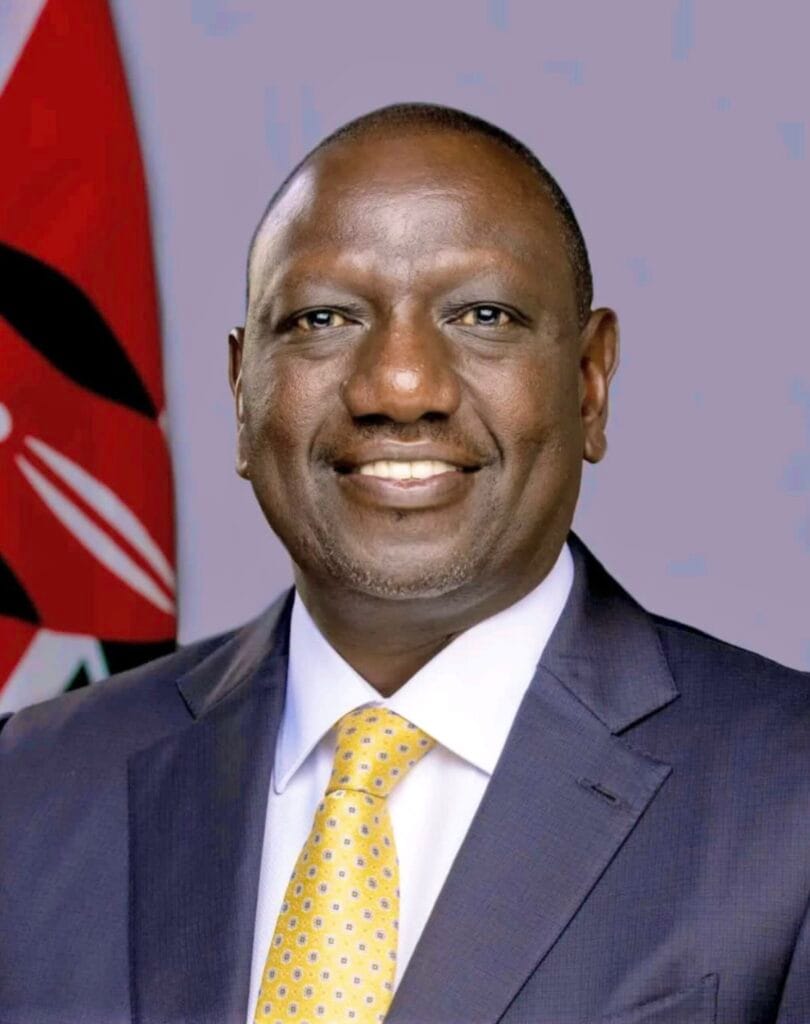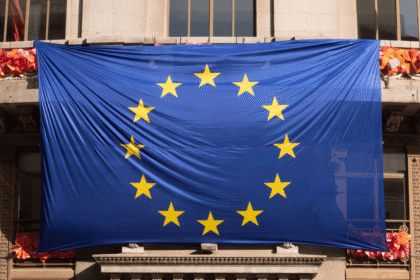
H.E President William Samoei Ruto Official Potrait | Source: https://creativecommons.org/licenses/by-sa/4.0/
By Brian Ochieng, Reporting from Nairobi, Kenya
NAIROBI, KENYA – President William Ruto’s presidency, now in its second year, is grappling with profound economic strains, an unprecedented wave of youth-led protests, and intricate political maneuverings.
While President Ruto has publicly stated his primary focus is on national transformation, not re-election, his declared confidence in securing a second term in 2027 underscores the inherent political stakes that influence every major government decision and societal reaction.
This report, filed from the heart of Nairobi, delves into the interconnected challenges defining Kenya’s current trajectory and their implications for the upcoming polls.
The Economic Imperative: Unpacking the Burden on Kenyans
President William Ruto’s ascent to power in 2022 was predicated on a promise to uplift the common citizen, the “hustlers,” by tackling economic stagnation and corruption. His administration championed a “Bottom-Up Economic Agenda” designed to inject vitality into grassroots enterprises and ease the financial burden on households.
However, nearly two years in, the prevailing narrative among many Kenyans points to aggressive tax policies and a persistent high cost of living that have significantly eroded public trust and fueled widespread discontent.
Policy Implementation and Public Backlash: The Finance Bill 2024
The most recent flashpoint for public anger was the proposed Finance Bill 2024. While the government maintained that new taxes were essential for national fiscal health and to service burgeoning public debt, critics argued these measures would disproportionately affect low-income households and small businesses, the very demographic Ruto vowed to champion.
The withdrawn bill had far-reaching implications.It proposed a Value Added Tax on ordinary bread, a staple food item, and on the transportation of sugarcane from farms to milling factories. Locally assembled mobile phones, electric bikes, solar and lithium-ion batteries, and electric buses were also targeted for this VAT.
Furthermore, an excise duty was proposed on vegetable and seed oils, alongside an increase in the Road Maintenance Levy per liter of fuel. These direct hikes on necessities and transportation would have severely strained urban populations, particularly in Nairobi.
The digital economy, a significant employer and service provider in the capital, faced a proposed excise duty on financial services, telephone and internet services, lottery, betting, gaming, and online advertisements. Even vehicle owners faced a proposed motor vehicle tax, initially capped at KES 100,000 but later amended to remove the ceiling.
The introduction of these measures, coupled with the prior removal of fuel subsidies, directly contradicted President Ruto’s campaign pledges of easing financial burdens. This perceived betrayal, especially among his core “hustler” base, has fostered a deep sense of disillusionment.
The government’s claims of economic improvement—inflation dropping from 9.6% to 3.8%, the shilling stabilizing from KES 165 to KES 130 against the dollar, and an increase in dollar reserves from $7 billion to $10.8 billion—have often been met with skepticism on the ground.
While a 2kg packet of maize has indeed seen its price drop from KES 240 to between KES 100-160, and fertilizer from KES 7,500 to KES 2,500, the overall cost of living remains stubbornly high for many. The disconnect between official statistics and the lived experiences of ordinary Kenyans fuels a pervasive public distrust.
Samuel Nyandemo, an economics lecturer at the University of Nairobi, cautions that the populace’s patience is “eroding,” signaling potential “animosity.”
Flagship Policies Under Scrutiny
Beyond direct taxation, the implementation of President Ruto’s key social programs has also been marred by controversy, particularly impacting residents of Nairobi and other urban centers. His flagship Affordable Housing Programme, intended to provide affordable homes, faces significant legal and financial obstacles.
The mandatory national housing levy was successfully challenged in court and declared “discriminatory and irrational,” as well as unconstitutional due to a lack of proper legal framework. This ruling effectively halted mandatory deductions and led to some refunds. Even the lowest-cost “affordable homes” at KES 1 million (approximately US7,600) remain largely inaccessible to most Kenyan workers, whose average monthly salary hovers around KES 14,000 (US106).
The contentious bidding process for house allocation, rather than guaranteed access for contributors, further fuels public cynicism. Allegations of forced land cessions from local governments and evictions to make way for new constructions have also plagued the program, especially in densely populated areas around Nairobi.
Similarly, the new Higher Education Funding Model, unveiled in May 2023, aimed to enhance accessibility but encountered significant challenges. The Means Testing Instrument (MTI), used by the Higher Education Loans Board (HELB), was criticized for miscategorizing many low-income students into higher financial bands, leaving them unable to afford tuition or facing substantial debt.
This flaw sparked widespread student protests across public universities, including those prominently located in Nairobi, disrupting academic calendars. The Kenya Human Rights Commission (KHRC) termed the model discriminatory, leading to its temporary suspension by the High Court in October 2024.
These repeated policy failures, perceived as ill-conceived and poorly executed, reinforce the narrative that the government is out of touch with the struggles of its citizens, thus contributing to the broader anti-establishment sentiment.
Gen Z’s Uprising: A Digital Revolution of Dissent

Image designed and generated by Canva Design AI – Prompt by Brian Ochieng
The protests against the Finance Bill 2024 rapidly transcended their initial economic focus, morphing into a potent, nationwide youth-led revolt. This movement, largely driven by Generation Z, has redefined Kenyan activism through unprecedented mobilization tactics and a broader anti-establishment agenda, with Nairobi as its vibrant epicenter.
From Tax Protest to Systemic Demands
The initial opposition to the Finance Bill was a direct response to tangible economic burdens. However, the movement quickly deepened, propelled by a series of critical incidents. The death of former teacher and blogger Albert Ojwang in police custody in June 2025, following alleged criticism of the deputy head of police, ignited widespread outrage in Nairobi, sparking protests demanding accountability for police brutality.
This anger escalated further when a police officer was filmed shooting and killing a street vendor selling masks to protesters, a visible act of state violence that galvanized more public support.
These incidents transformed the protests into a comprehensive challenge to the state’s legitimacy. While the Finance Bill was eventually withdrawn, the protests persisted, broadening their demands to include systemic inequality, a direct response to the administration’s perceived oversight of a deteriorating economy and austerity measures disproportionately affecting the poor.
They also called for an end to police violence, driven by numerous reports of brutality and specific incidents like Ojwang’s death and the street vendor shooting. Increasing authoritarianism, a reaction to perceived shifts towards authoritarian rule under President Ruto, notably the controversial application of anti-terror laws, also became a key demand.
Deeper grievances against endemic corruption and economic exclusion were addressed as root causes of Kenya’s problems. Ultimately, calls for President Ruto’s resignation escalated as the movement gained momentum, reflecting a fundamental disillusionment with the current political order.
The Digital Vanguard: Gen Z’s Innovative Tactics
Generation Z’s unparalleled digital fluency has been the engine of this new activism. They have effectively leveraged technology to bypass traditional media gatekeepers and political structures, making their movement remarkably resilient and decentralized.
Social media platforms like X (formerly Twitter), TikTok, and Instagram became primary channels for organizing and disseminating information. Hashtags such as #RutoMustGo and #EndPoliceBrutalityKE rapidly trended, amplifying their message globally.
Activists innovatively translated complex legislative details of the Finance Bill into local languages, making them accessible to a wider audience. They utilized Artificial Intelligence tools like ChatGPT to answer public queries about the bill, demonstrating a sophisticated approach to public education.
Strategic leaking of phone numbers of political leaders enabled mass SMS and WhatsApp messaging campaigns, fostering direct public engagement with decision-makers. This tech-savvy, organic, and decentralized approach has made the movement less susceptible to traditional forms of government control or co-option.
It has allowed activists to present themselves as informed and legitimate agents of change, challenging stereotypes of politically immature youth.
State Repression and Human Rights Concerns
The Ruto administration’s response to the protests has been characterized by a hardline and often violent approach, leading to significant human rights concerns. Thousands of security personnel have been deployed across major urban centers, including Nairobi, Kisumu, and Eldoret.
Peaceful demonstrators have been met with live ammunition, tear gas, and water cannons. The Kenya National Commission on Human Rights (KNCHR) reported that at least 38 people were killed and 130 wounded on July 7, 2025, alone during the Saba Saba Day clashes, making it one of the deadliest days of unrest.
Overall casualty figures are widely expected to be significantly higher. There has been a concerning surge in abductions, with human rights groups estimating over 80 incidents in the past year and dozens still unaccounted for.
Activists have reportedly been subjected to extrajudicial abductions and interrogations aimed at silencing dissent. Alarmingly, at least 71 individuals, including an opposition member of parliament, face terrorism charges—a move condemned as excessive and a troubling precedent, given that the Prevention of Terrorism Act explicitly exempts protesters. President Ruto escalated his rhetoric, branding demonstrators as “terrorists” and criminals.
He issued orders for security forces to shoot protesters damaging property “in the leg,” echoing earlier “shoot on sight” directives. The government also reportedly attempted to censor live coverage of protests and restricted internet access and Telegram ahead of the Saba Saba demonstrations, while intimidating journalists.
The opposition coalition has gone as far as accusing Kenyan police of operating as a “death squad in uniform” and threatening to seek Ruto’s referral to the International Criminal Court (ICC). This increasingly repressive environment, particularly evident in Nairobi, risks stifling legitimate democratic expression and civil liberties, potentially pushing dissent underground or towards more radical forms.
The Political Chessboard: Alliances, Ambitions, and Opposition Fragmentation
President Ruto’s political landscape is being continually reshaped by a complex interplay of strategic alliances, internal party dynamics, and the emergence of new political forces, all with significant implications for the 2027 General Elections.
The Ruto-Odinga Pact: A Strategic Embrace?
A defining feature of the current political moment is the political pact between President William Ruto and his long-time rival, veteran opposition leader Raila Odinga. Formalized by a 10-point Memorandum of Understanding (MoU) signed in March 2024, this alliance is widely perceived as a calculated move by Ruto to neutralize a formidable opposition figure and consolidate power ahead of his 2027 re-election bid.
Many analysts suggest that victory might be impossible without Odinga’s strategic support. This pact bears a strong resemblance to Odinga’s 2018 “handshake” with Ruto’s predecessor, Uhuru Kenyatta, which aimed to expand the executive through the Building Bridges Initiative (BBI).
While the BBI was later struck down by theSupreme Court as unconstitutional, the current MoU formalizes an “unofficial unity government,” with Odinga’s Orange Democratic Movement (ODM) already having several ministers co-opted into Ruto’s cabinet since July 2023.
The 10 points within the MoU are largely aspirational, encompassing broad objectives such as combating corruption, creating youth employment (with specific mention of Nairobi’s role in job creation), auditing national debt, promoting devolution, and enhancing government efficiency.
A key recommendation from the National Dialogue Committee (NADCO) report, which the pact commits to implementing, is the establishment of an executive Prime Minister and the Office of the Official Opposition Leader. However, creating a Prime Minister’s office would almost certainly necessitate a constitutional amendment, a process that has proven difficult and contentious in Kenya’s past.
For Ruto, the pact is a clear strategic maneuver. State House has reportedly invested heavily in Odinga’s campaign to chair the African Union Commission. A successful bid by Odinga for this continental role would likely solidify a Ruto-Odinga coalition for the 2027 elections, effectively removing a major rival from the domestic political scene.
However, the deal has divided the nation. Critics label it a “stitch-up by the tribal kingpins,” undermining healthy democratic competition and accountability by effectively integrating the main opposition party into the government.
This blurring of lines, they argue, could exacerbate poor economic governance. Notably, the pact does not outline a formal political coalition between ODM and Ruto’s United Democratic Alliance (UDA), a detail reportedly included to appease skeptical ODM factions, particularly those led by Secretary-General Edwin Sifuna.
However, Odinga’s co-option of ministers has already “tarnished his reputation” among parts of his traditional base. Similarly, the pact risks alienating Ruto’s own “hustler” supporters, who feel betrayed by current economic policies and may view the alliance as another elite political arrangement, further eroding their trust.
The “Anyone But Ruto” Alliance and New Contenders
Despite the Ruto-Odinga pact, a broader opposition coalition is coalescing under the banner of “Anyone But Ruto” for 2027. This alliance includes prominent figures like Wiper leader Kalonzo Musyoka, former Deputy President Rigathi Gachagua, Fred Matiang’i, and Martha Karua.
Former Deputy President Rigathi Gachagua has been an outspoken critic of President Ruto, dismissing his recent Nairobi tour as a “total embarrassment” and accusing the head of state of ignoring lawlessness during the visit.
Gachagua explicitly dismissed the Ruto-Odinga pact as a “mere survival tactic,” labeling Odinga a “mere Ruto employee” who lacks significant support from the Mount Kenya region. Such internal criticisms from a former close ally highlight the fractures within Ruto’s own political backyard.
Former Chief Justice David Maraga, a figure renowned for his integrity and landmark rulings, has re-emerged as a vocal critic of the Ruto administration. Maraga is most remembered for nullifying the 2017 presidential election—a bold move that challenged executive power and led to an “unprecedented feud” with then-President Uhuru Kenyatta.
Maraga has consistently criticized “executive retaliation” in the form of budget cuts, revealing a 50% slash in the judiciary’s development and recurrent expenditure and the complete removal of its Kshs.400 million ICT vote. He argues this “strangling the Judiciary results in a failure to get expeditious delivery of services” for Kenyans and warns of a nation “on the brink of becoming a failed state” due to constitutional violations and state-instigated terror.
Maraga’s recent declaration of interest in the 2027 presidency, positioning himself as a “third force” distinct from the “United Opposition,” transforms his institutional critiques into a direct political challenge. His focus on the rule of law and anti-corruption could resonate with segments of the electorate, including the disenchanted Gen Z.
Former Interior Cabinet Secretary Fred Matiang’i, once dubbed “super minister” due to his vast influence under former President Kenyatta, has declared his intention to vie for the presidency in 2027, receiving an endorsement from the Jubilee Party. Matiang’i’s past relationship with Ruto was contentious, with Ruto accusing him of frustrating his presidential bid.
Despite Raila Odinga recently downplaying Matiang’i’s chances, Matiang’i is notably identified as the “only establishment politician with significant support from Gen Z.” He has publicly criticized the Ruto administration for unfulfilled promises, perceived record violence, failing schools, and operating as a “government of excuses.”
His appeals to accountability and direct criticism of the use of terrorism charges against youth protesters align closely with key Gen Z grievances. Matiang’i’s re-emergence could represent a shift towards a more technocratic political discourse, emphasizing competence and accountability, offering an alternative to traditional ethnic or patronage politics. The political landscape is highly fluid.
The internal friction within the “Anyone But Ruto” alliance, coupled with the independent ambitions of figures like Maraga and Matiang’i, suggests a potential for vote splitting that could inadvertently benefit Ruto. However, it also signifies a societal search for new leadership that genuinely resonates with deep-seated public grievances, moving beyond historical political affiliations towards issue-based alliances.
Kenya’s Defining Moment: The Road to 2027 and Beyond
President William Ruto’s administration is navigating a complex web of economic distress, unprecedented youth activism, and shifting political alliances. His confident stride towards the 2027 General Elections is underpinned by official claims of economic stabilization and strategic political consolidation, yet it is shadowed by widespread public discontent and fundamental challenges to democratic norms.
The current trajectory indicates a heightened period of political volatility for Kenya. The economic hardship directly fueled the Gen Z protests, which in turn have been met with a hardline, at times repressive, government response.
This cycle risks intensifying social unrest, eroding democratic institutions, and fostering a pervasive sense of distrust in political solutions. The government’s alleged attacks on the judiciary, highlighted by Maraga’s warnings, and the controversial application of anti-terror laws undermine the very institutions meant to uphold the rule of law and protect citizens’ rights.
The Ruto-Odinga pact, while a shrewd political strategy, is viewed with skepticism by many, further deepening public cynicism. The enduring influence of the Gen Z movement, characterized by its innovative digital mobilization and its broad anti-establishment demands, represents a powerful new force that cannot be easily dismissed or co-opted by conventional political structures.
Their demonstrated willingness to continue protesting despite state repression indicates a deep-seated commitment to fundamental change, pushing for greater accountability and transparency. This suggests that future elections will increasingly be influenced by issues of governance and economic justice, rather than solely by ethnic arithmetic.
Ultimately, Kenya’s long-term stability hinges on its leadership’s capacity to genuinely acknowledge, engage with, and address the grievances of its populace, particularly the burgeoning youth demographic.
Without genuine dialogue, meaningful reforms that alleviate economic burdens, and a renewed commitment to democratic principles and the rule of law, the nation risks prolonged social unrest and a deepening crisis that could profoundly impact its stability and democratic future.
The period leading up to and beyond 2027 will undoubtedly be a critical test of Kenya’s resilience and its leadership’s ability to navigate these multifaceted and intricate challenges.













